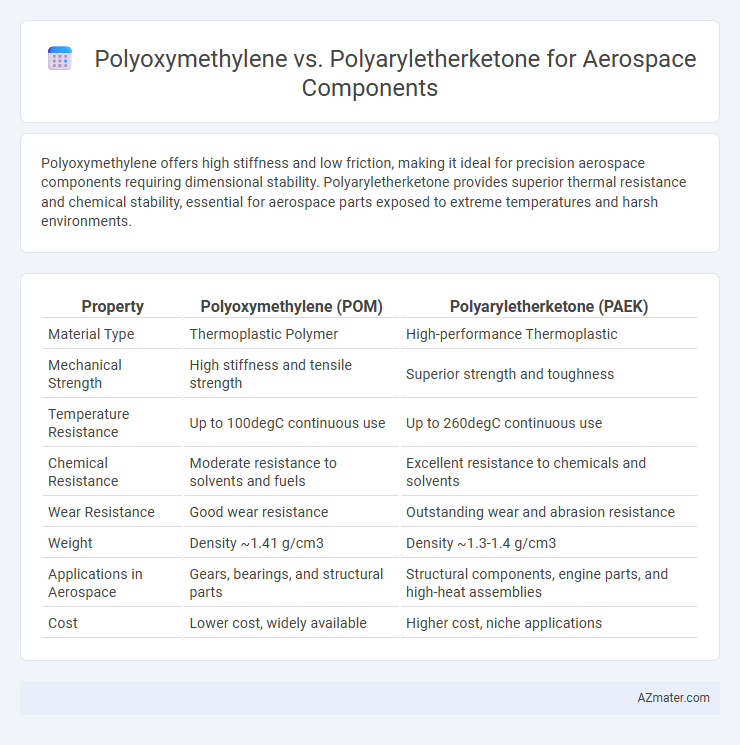Polyoxymethylene offers high stiffness and low friction, making it ideal for precision aerospace components requiring dimensional stability. Polyaryletherketone provides superior thermal resistance and chemical stability, essential for aerospace parts exposed to extreme temperatures and harsh environments.
Table of Comparison
| Property | Polyoxymethylene (POM) | Polyaryletherketone (PAEK) |
|---|---|---|
| Material Type | Thermoplastic Polymer | High-performance Thermoplastic |
| Mechanical Strength | High stiffness and tensile strength | Superior strength and toughness |
| Temperature Resistance | Up to 100degC continuous use | Up to 260degC continuous use |
| Chemical Resistance | Moderate resistance to solvents and fuels | Excellent resistance to chemicals and solvents |
| Wear Resistance | Good wear resistance | Outstanding wear and abrasion resistance |
| Weight | Density ~1.41 g/cm3 | Density ~1.3-1.4 g/cm3 |
| Applications in Aerospace | Gears, bearings, and structural parts | Structural components, engine parts, and high-heat assemblies |
| Cost | Lower cost, widely available | Higher cost, niche applications |
Introduction to Polyoxymethylene (POM) and Polyaryletherketone (PAEK)
Polyoxymethylene (POM), a thermoplastic known for its high stiffness, low friction, and excellent dimensional stability, is widely used in aerospace components requiring precise machining and wear resistance. Polyaryletherketone (PAEK) offers superior thermal stability, chemical resistance, and mechanical strength, making it ideal for high-performance aerospace applications exposed to extreme environments. The comparison highlights POM's cost-effectiveness and ease of processing against PAEK's enhanced durability and temperature tolerance critical for aerospace component longevity.
Material Properties Comparison: POM vs PAEK
Polyoxymethylene (POM) offers high dimensional stability, excellent machinability, and low friction, making it suitable for lightweight aerospace components requiring precision. Polyaryletherketone (PAEK) exhibits superior thermal resistance, exceptional mechanical strength, and outstanding chemical resistance, ideal for high-performance aerospace parts exposed to extreme environments. Comparing POM and PAEK, PAEK outperforms in temperature tolerance and durability, while POM provides cost-effective solutions with good tribological properties for less demanding aerospace applications.
Mechanical Performance in Aerospace Applications
Polyaryletherketone (PAEK) exhibits superior mechanical performance compared to Polyoxymethylene (POM) in aerospace components, offering higher tensile strength, excellent thermal stability, and exceptional chemical resistance under extreme conditions. PAEK materials maintain structural integrity at elevated temperatures above 250degC, critical for aerospace applications involving exposure to high heat and mechanical stress. In contrast, POM's lower glass transition temperature and reduced dimensional stability limit its use in high-performance aerospace components requiring long-term durability and resistance to fatigue.
Thermal Stability and Heat Resistance
Polyaryletherketone (PAEK) exhibits superior thermal stability and heat resistance compared to Polyoxymethylene (POM), making it more suitable for aerospace components exposed to extreme temperatures. PAEK maintains mechanical properties at continuous operating temperatures up to 250degC, while POM typically degrades above 120degC, limiting its high-temperature application. The high glass transition and melting points of PAEK contribute to its exceptional thermal endurance and dimensional stability in aerospace environments.
Chemical Resistance and Durability
Polyaryletherketone (PAEK) exhibits superior chemical resistance compared to Polyoxymethylene (POM), withstanding aggressive solvents, acids, and high-temperature environments typical in aerospace applications. PAEK offers enhanced durability through outstanding mechanical strength and thermal stability up to 250degC, making it ideal for long-term use in demanding aerospace components. In contrast, POM, while exhibiting good dimensional stability and fatigue resistance, degrades more readily under chemical exposure and elevated temperatures beyond 120degC, limiting its application in harsh aerospace environments.
Weight and Structural Efficiency
Polyoxymethylene (POM) offers lightweight properties and excellent dimensional stability but has limited high-temperature resistance, making it less ideal for critical aerospace structural components. Polyaryletherketone (PAEK), including PEEK variants, provides superior strength-to-weight ratio, exceptional thermal stability up to 250degC, and outstanding chemical resistance, enhancing structural efficiency in aerospace applications. The enhanced mechanical performance and resistance characteristics of PAEK contribute to weight reduction while maintaining high structural integrity essential for aerospace component durability.
Processing and Manufacturing Considerations
Polyoxymethylene (POM) offers excellent dimensional stability and ease of machining, making it suitable for precise aerospace components requiring tight tolerances, but its thermal resistance is lower compared to Polyaryletherketone (PAEK). Polyaryletherketone exhibits superior high-temperature resistance and chemical stability, ideal for aerospace parts exposed to extreme conditions, though it demands specialized processing techniques such as high-temperature injection molding or compression molding. Manufacturing with PAEK involves longer cycle times and stricter temperature controls, whereas POM allows faster production but may require additional treatments to enhance thermal performance for aerospace applications.
Cost Analysis: POM vs PAEK
Polyoxymethylene (POM) offers a significantly lower material cost compared to Polyaryletherketone (PAEK), making it a budget-friendly option for aerospace components with lower temperature and mechanical demands. PAEK, while more expensive, delivers superior thermal resistance, chemical stability, and mechanical performance essential for high-stress aerospace environments, justifying its higher initial investment. Cost analysis must weigh POM's affordability against PAEK's long-term durability and performance benefits to determine the optimal material for specific aerospace applications.
Typical Aerospace Component Applications
Polyaryletherketone (PAEK) is commonly used in aerospace components like lightweight structural parts, connectors, and electrical insulators due to its exceptional thermal resistance and mechanical strength, outperforming polyoxymethylene (POM) in high-temperature environments. Polyoxymethylene finds application in precision gears, bearings, and fasteners where low friction and dimensional stability are critical, but its lower heat resistance limits its use in extreme aerospace conditions. The choice between PAEK and POM depends on specific aerospace demands, with PAEK favored for components exposed to high stress and heat, while POM suits applications requiring wear resistance and machining precision.
Conclusion: Selecting the Ideal Polymer for Aerospace
Polyaryletherketone (PAEK) outperforms polyoxymethylene (POM) in aerospace applications due to its superior thermal stability, chemical resistance, and mechanical strength at elevated temperatures. PAEK polymers maintain structural integrity in extreme environments, making them ideal for critical aerospace components exposed to high stress and temperature fluctuations. Selecting PAEK ensures enhanced durability, reliability, and performance, crucial for advancing aerospace technology and safety standards.

Infographic: Polyoxymethylene vs Polyaryletherketone for Aerospace Component
 azmater.com
azmater.com